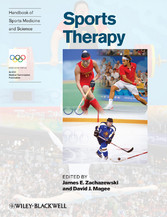Suchen und Finden
Handbook of Sports Medicine and Science : Sports Therapy Services Organization and Operations
3
Contents
7
List of Contributors
8
Foreword
10
Preface
11
Chapter 1 Sports therapy—Who? What? When? Where? Why? and How?
13
Introduction
13
What is sports therapy?
13
Who practices sports therapy
14
What makes a good sports therapist (characteristics and commitment of a sports therapist)?
17
When and where is the sports therapist needed?
18
Why is sports therapy important?
18
How does one become a sports therapist?
19
Summary
20
References
20
Chapter 2 A history of sports medicine and sports therapy
21
Introduction
21
Defining “sports medicine” and “sports therapy”
21
Where and when did sports medicine and sports therapy begin?
22
Ancient times
23
Modern times—organizational development
26
Summary
29
Recommended readings
29
Chapter 3 The role and importance of the sports therapist: pre-event, event, and post-event
31
Introduction
31
The athlete’s perspective
31
Chief medical officer’s (CMO) perspective
32
Forming a medical team
32
The Olympic Village
33
The physician’s perspective
33
Preparation of equipment
34
Health screening
34
The athlete’s confidence in the physician
34
The Olympic therapist’s perspective
35
Preparations before the Olympic Games
35
Equipment
36
24-hour service during the Olympic Games
36
Traveling with teams—Is the therapist just “a therapist”?
36
Other roles of the therapists
36
Chapter 4 Hosting international Olympic events: providing host therapy services at major games
37
Introduction
37
Planning for the games
37
Understanding the therapy needs
38
Getting the right people
39
Having the right tools to do the job
42
Communication is key
45
Let the games begin
46
The finishing touches
46
“Getting the team to gel”
47
Welcoming the world to our facility
49
Following the games
51
References
52
Chapter 5 Pre-Olympic team travel: logistical and treatment considerations
53
Introduction
53
Pre-event training camp
53
Preparation for the training camp
56
Traveling to the training site/Olympic Games
57
Providing therapy services while traveling with a team
58
Working with other health professionals “at a distance” or in different jurisdictions (e.g., traveling with a team when the therapist is the only support)
58
How/who to seek information from regarding referrals, logistics, and supplies if traveling internationally with a team
59
Reference
59
Chapter 6 Olympic event: logistical and treatment considerations
60
Background and typical role definition within an Olympic Games environment
60
Planning—prior to departure
61
Service prioritization for recruitment
61
Coordinating services with sports-specific physiotherapy staff
63
Managing expectations based on accreditation and access limitations
63
Travel
64
Planning amount, type, and freight of equipment
64
Information gathering visit
66
Communication
66
Planning—on arrival
67
Unpacking, stock check, and clinic setup
67
Volunteer domestic services provision
67
Check each venue and meet emergency personnel
68
Communication between team medical professionals and host country and team officials
69
Prioritizing service provision
69
Logistics
70
Precompetition period following official opening
71
During competition period
71
Managing service provision on a day-to-day basis
71
Venue coverage
72
NOC clinic cover for recovery/injury management
72
Venues coverage and manning NOC clinic in the village
73
Liaising with sports-specific physiotherapists for when they need help
73
Covering venues where there is no sports-specific cover
73
Responding to changing circumstances
73
Concluding stages
74
Packing up
74
Staff appraisal
75
Debrief report
75
Suggested reading
79
Chapter 7 The importance of communication: understanding the importance of the event to the athlete, coach, and others
80
Introduction
80
Developing a sports medicine communication strategy
80
Collaborative communication
83
Athlete communications
84
Steps for the successful patient communication process
85
Coach communications
86
Games communications
86
Games communication strategy
87
Primary communication
87
Secondary communication
88
Sports medicine team communications
88
Public relations strategy
89
Crisis communication skills
90
References
90
Chapter 8 Considerations for working with professional athletes versus nonprofessional amateur athletes during Olympic events
91
Introduction
91
Working with athletes
92
Clinical reasoning for injury prevention and rehabilitation of athletes
92
The sport context: professionals versus amateurs
93
Working with professional athletes
94
Working with amateur athletes
95
Examples of the Brazilian sports therapist’s role in football (soccer) and volleyball
97
Official versus private therapist working with Olympic athletes
100
References
101
Chapter 9 To compete or not to compete following injury during Olympic events
103
Introduction
103
Understanding aspects in the clinical decision-making process
104
What is clinical reasoning?
104
Why is good clinical reasoning so important?
105
The role of the sports physiotherapist in relationship to physicians and other medical staff
105
The process of making a return to sport decision
107
Impact of decision on team performance or an individual athlete’s career
109
Preparation can improve clinical decision making
110
Impact of the short time available to work within injury constraints and rehabilitation processes at an Olympic Game
110
Communication of decisions with athlete, coach, team officials
111
Conflict of interest
112
Press and media scrutiny
112
Key concerns of the sports therapist at major events/competitions
112
The athletes’ follow-up
113
References
114
Chapter 10 Sports nutrition and therapy
115
Introduction
115
Repair and regeneration of injured tissues
115
Nutritional strategies to protect muscle protein balance
116
Nutrients with anti-inflammatory properties
120
Bone and connective tissue
121
Adjusting energy and nutrient intake to altering requirements
122
Communication between nutritionist/dietician and sports therapy team
125
Reference
127
Further readings
127
Appendix: Olympic sports medicine contacts
129
Index
135
Alle Preise verstehen sich inklusive der gesetzlichen MwSt.







